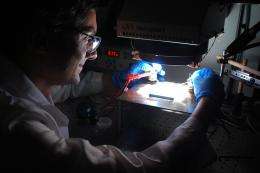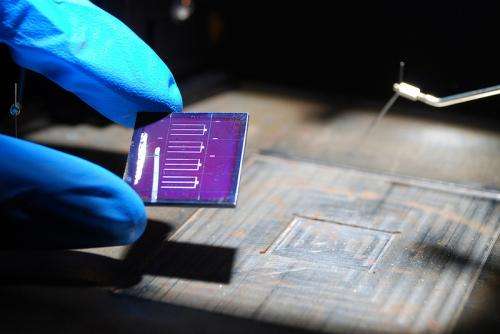August 21, 2012 report
IBM sets new efficiency mark for abundant material solar cell

(Phys.org) -- IBM’s Material Sciences team has reached a new level of efficiency for a thin film solar cell made from the easily accessible materials copper, zinc, tin, and selenium, known as CZTS. The team, in a report by photovoltaic researchers David Mitzi and Teodor Todorov, say they have bested the previous record by ten percent, bumping it to 11.1%.
Several teams across the globe are hard at work trying to create thin film solar cells from materials that are easier to obtain than those found in the more traditional CIGS (copper, indium, gallium, selenium) thin film material. Gallium and selenium in particular are becoming more difficult to get because of restrictions by the Chinese government (China is the major producer for both) on exports.
Work on thin film solar cells became popular as the cost of silicon based solar cells rose over the past decade, now despite a downward cost trend, research on thin film cells has continued because of other high cost procedures required to make silicon based solar cells. Up till now however, most of that research has centered on CIGS, which typically has an efficiency rate of twelve percent in solar panels. The IBM research team is hoping to make CZTS even more efficient, perhaps reaching fifteen percent, which would of course make it a viable alternative to CIGS, though they don’t expect to reach that goal for at least another couple of years.
If the team succeeds than it’s possible production of electricity using thin film solar cells could jump dramatically, up to 500 gigawatts, the team predicts. Of course, IBM isn’t going it alone, they have partnered with Tokyo Ohka Kogyo, DelSolar and Solar Frontier.

In addition to boosting the efficiency of its thin film cells, the IBM team reports that their cells can be made using a simple additive production technique rather than the more expensive etching required to make silicon based cells. They also note that despite the massive amount of money that has been spent over the years by various research groups on developing solar cell technology, just one percent of the world’s electricity comes from it, a number the company would like to see bumped up by solar panels that employ their CZTS cells.
More information: ibmresearchnews.blogspot.com/2 … ew-frontiers-of.html
© 2012 Phys.org


















